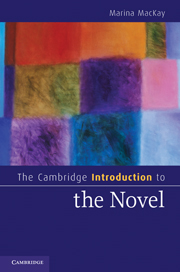Book contents
- Frontmatter
- Contents
- Acknowledgments
- About this book
- Chapter 1 Why the novel matters
- Miguel de Cervantes, Don Quixote (1605, 1615)
- Chapter 2 Origins of the novel
- Laurence Sterne, The Life and Opinions of Tristram Shandy, Gentleman (1759–67)
- Chapter 3 Narrating the novel
- James Hogg, The Private Memoirs and Confessions of a Justified Sinner (1824)
- Chapter 4 Character and the novel
- Nathaniel Hawthorne, The Scarlet Letter (1850)
- Chapter 5 Plotting the novel
- Gustave Flaubert, Madame Bovary (1857)
- Chapter 6 Setting the novel
- Charles Dickens, Bleak House (1853)
- Chapter 7 Time and history
- Virginia Woolf, To the Lighthouse (1927)
- Chapter 8 Genre and subgenre
- Graham Greene, The Ministry of Fear (1943)
- Chapter 9 Novel and anti-novel
- Thomas Pynchon, The Crying of Lot 49 (1966)
- Chapter 10 Novel, nation, community
- Salman Rushdie, Midnight's Children (1981)
- Chapter 11 Concluding
- Notes
- Glossary
- Further reading
- Index
- Cambridge Cultural Social Studies
Chapter 10 - Novel, nation, community
Published online by Cambridge University Press: 05 June 2012
- Frontmatter
- Contents
- Acknowledgments
- About this book
- Chapter 1 Why the novel matters
- Miguel de Cervantes, Don Quixote (1605, 1615)
- Chapter 2 Origins of the novel
- Laurence Sterne, The Life and Opinions of Tristram Shandy, Gentleman (1759–67)
- Chapter 3 Narrating the novel
- James Hogg, The Private Memoirs and Confessions of a Justified Sinner (1824)
- Chapter 4 Character and the novel
- Nathaniel Hawthorne, The Scarlet Letter (1850)
- Chapter 5 Plotting the novel
- Gustave Flaubert, Madame Bovary (1857)
- Chapter 6 Setting the novel
- Charles Dickens, Bleak House (1853)
- Chapter 7 Time and history
- Virginia Woolf, To the Lighthouse (1927)
- Chapter 8 Genre and subgenre
- Graham Greene, The Ministry of Fear (1943)
- Chapter 9 Novel and anti-novel
- Thomas Pynchon, The Crying of Lot 49 (1966)
- Chapter 10 Novel, nation, community
- Salman Rushdie, Midnight's Children (1981)
- Chapter 11 Concluding
- Notes
- Glossary
- Further reading
- Index
- Cambridge Cultural Social Studies
Summary
She had dedicated herself … to making sense of what Inverarity had left behind, never suspecting that the legacy was America.
Thomas Pynchon, The Crying of Lot 49 (1966)What seemed a private quest on the part of Pynchon's Oedipa Maas has suddenly turned public. The dead Pierce Inverarity has left behind not a private game for a former girlfriend, but a shared legacy: even in this atomized and narcissistic postmodern culture Oedipa sees that she remains part of a community, one among many of the collective inheritors of “America.” Perhaps this comes as an unexpected revelation in a novel so preoccupied by what divides rather than unites people, but it is also a deeply significant one because it speaks to the novel's resources as a form. That is, because novels are typically both subjective and intersubjective, about social existence but also about individual experiences of social existence, among all the major literary genres this is the one most strongly associated with the imagining and perpetuation of communities. If there's one reason why the novel is the dominant literary form in the world today, this may be it.
Representing the part and the whole
A novel makes a part of something stand for the whole thing. Rhetoricians call this trope “synecdoche,” the figure of speech by which a poem's sheep are “fleeces” and its ships “masts.”
- Type
- Chapter
- Information
- The Cambridge Introduction to the Novel , pp. 162 - 171Publisher: Cambridge University PressPrint publication year: 2010

